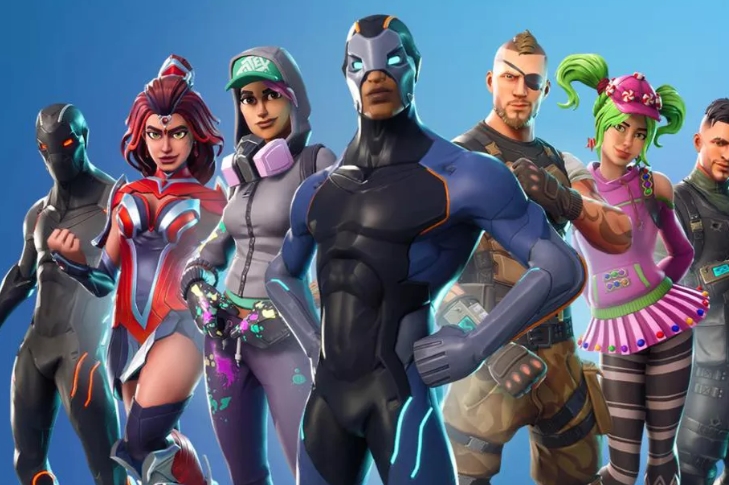
When Epic Games revealed the big surprise of Fortnite’s fourth season earlier this week, fans could both see it coming and retain that giddy kid-on-Christmas-morning feeling. The developer planned the reveal for months: a meteor in the sky hovered over the game’s map since January, and on Tuesday it crashed into the world of Fortnite to create a massive crater with gravity-defying extraterrestrial power-ups scattered about. In addition to the meteor crash, Epic transformed its map in subtle but powerful ways, adding new structures, secret underground lairs, and other goodies in service to its new superhero theme.
Most players expected something to this effect, and yet the Fortnite community has been effusive in its praise for how the build up and eventual execution was pulled off. It was a shared gaming experience like no other. And that’s what makes season four of Fortnite feel like a crucial turning point for the battle royale game, which remains fundamentally about sending 100 human players to a deserted island to loot, build, and shoot their way to victory. The experience still revolves around that same satisfying survival cycle. But the holistic Fortnite experience is fast resembling something closer to a massively multiplayer online game, with a constantly updated narrative, a persistent world that changes all at once for every player, and a fan base with the means to customize and outfit an avatar in increasingly sophisticated ways.
/cdn.vox-cdn.com/uploads/chorus_asset/file/10783027/fortnite_season_4_map_new.jpg)
Starting with season three and culminating with last Tuesday’s reveal, Epic began crafting a narrative for Fortnite that felt giant and ambitious in ways few other online games have ever pulled off. Players theorized about an incoming alien invasion, and whether Epic was planning on destroying the controversial in-game metropolis Tilted Towers as a way to tell a story and adjust the game’s competitive landscape at the same time. While it was Dusty Depot, and not Tilted Towers, that suffered deep impact, the effect remains the same. Epic crafted a narrative for an online multiplayer game exclusively out of contextual clues, in-game hints, and other forms of environmental storytelling. The end result is a game that feels richer, deeper, and more purposeful than its battle royale trappings would have you believe.
Epic didn’t stop with the comet landing. The new superhero theme is also an ingenious way to build another layer onto the ongoing story and give players even more ways to express themselves. There are new costumes to unlock and goofy emotes, one even culled from a popular internet meme. But this season, Epic included two superhero skins that can only be upgraded by playing the game, performing challenges, and leveling up using in-game experience points. You can’t buy your way to these upgrades; you have to earn them, just like in any hardcore role-playing game. The substantial upgrade paths, unlockable rewards, and the persistent but ever-changing game map make Fortnite a much meatier experience than Playerunknown’s Battlegrounds, which has static, unchanging environments and otherwise boring customization options.
/cdn.vox-cdn.com/uploads/chorus_asset/file/10785087/fortnite_carbide_challenges.jpg)
In this way, Fortnite feels like a more realized version of Bungie’s Destiny, a game that ambitiously tried and never quite succeeded at blending the best of shooter and MMO game design. Like Destiny, Fortnite lets players engage in a shared world, customize characters, and, now, upgrade those customization options through in-game activities. But unlike Bungie, Epic puts its world-building and other update efforts toward the competitive multiplayer battle royale mode, without worrying too much about a traditional story or plot. Because Fortnite is free-to-play, players don’t expect anything outside the core experience, and they pay money only for cosmetic vanity items and nothing else.
Epic’s narrative and RPG-like focus isn’t a thematic side project or something the developer is doing just for fun. Focusing on world-building and giving players a communal story to rally around is a business imperative for a free-to-play game like Fortnite. The game can only stay relevant so long as players feel invested in what they’re doing. That doesn’t just mean playing the competitive multiplayer every day to unlock challenges or try and win a match. Being invested in Fortnite also means caring more deeply about what story Epic is trying to tell, where the game is headed, and how that interplay between narrative and gameplay will help the title evolve over time, like just the best of MMOs.
Also consider the Battle Pass, which urges players to log in every day and complete challenges to unlock better rewards that can only be earned and not bought. Every single core pillar of Fortnite, from its growing narrative to its in-game store to its seasonal competitive multiplayer approach, feeds into a cycle that helps the game stay relevant, popular, and lucrative. The players who are more invested then become more likely to spend real money.
So when people say the future of online gaming looks like Fortnite, they’re not just talking about the battle royale genre, which won’t feel so shiny and new a year from now. They’re talking about the blending of every good idea from the last decade of online gaming, from both the East and West. Like most MMOs, Fortnite is free-to-play, constantly updated, and massive multiplayer. And like the most successful games of the last few years regardless of genre, it’s free-to-play and cross-platform, makes money using vanity cosmetics, focuses on letting players tell their own stories, and incorporates community feedback on a regular basis.
All of these aspects will inform the way games are developed, marketed, and make money in the future. And Fortnite is leading the pack by illustrating just how to make this combination of genre elements, business model innovations, and raw fun factor have influential, industry-changing staying power.

